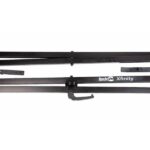Learning how to play muted notes on a guitar can add depth and rhythm to your playing.

You can achieve a muted, percussive sound by trying palm muting, fret-hand muting, or other common techniques.
This article will discuss these techniques and provide the steps to include muted notes in your guitar playing, so let’s dive right in.
Contents
How to Play a Muted Note on Guitar: 5 Different Techniques
Playing a muted note on the guitar can be done using various techniques, such as the following:
1. Palm Muting
As explained above, this technique involves lightly resting the side of your picking hand (palm) against the strings near the bridge.
It produces a muted, percussive sound. You can also try some of the following techniques.
Tips for Beginners:
- Start by placing the side of your palm lightly against the strings near the bridge.
- Experiment with the amount of pressure you apply to find the sweet spot where the strings are muted but still produce a clear sound.
2. Fret-Hand Muting
With this technique, you use your fretting hand to mute the strings. Here’s how to do it:
- Place your fingers on the desired frets to play a note or a chord.
- Extend the fingers of your fretting hand slightly so that they lightly touch the strings above or below the fretted notes.
- Apply enough pressure to mute the strings, preventing them from ringing out fully.
- Strum or pick the strings to produce the muted sound with your other hand.
Tips for Beginners:
- Begin by fretting a note or chord as you normally would.
- Gently extend your fingers so that they lightly touch the strings above or below the fretted notes.
- Practice applying enough pressure to mute the strings without completely stopping their vibrations.
3. Deadening with the Picking Hand
This technique involves using your picking hand to touch the strings to mute them. It’s often used for muting specific strings while playing chords or lead lines.
Here’s how to do it:
- Rest the edge of your palm or the side of your thumb against the strings you want to mute.
- Maintain enough pressure to prevent those strings from ringing out when you strum or pick the guitar.
- Be careful not to touch the strings you intend to play, as this will also silence them.
Tips for Beginners:
- When palm muting, try using the side of your thumb instead of your palm to mute specific strings.
- Start with lighter pressure and gradually increase it until you achieve the desired muting effect.
- Be mindful of your picking hand’s positioning to avoid inadvertently muting strings you intend to play.
4. String Muting With Additional Fingers
This technique is useful for muting adjacent strings to prevent unwanted string noise or sympathetic vibrations. Here’s how to do it:
- Use a finger on your fretting hand to fret a note or chord.
- Let one of the other fingers rest lightly against the adjacent strings, muting them.
- Strum or pick the strings to produce a clean sound without any unwanted string noise.
Tips for Beginners:
- Begin by fretting a note or chord with one finger.
- Use another finger from your fretting hand to lightly touch the adjacent strings, muting them.
- Practice finding the right balance between pressing down on the fretted note and muting the adjacent strings to achieve a clean sound.
5. Guitar Muting Accessories

You can also use accessories to achieve muted notes.
One such accessory is a string dampener, a device that clamps across the strings to mute them.
They’re particularly useful for advanced techniques like tapping or two-hand tapping, where you must control string noise.
Tips for Beginners:
- Position a string dampener across the strings just above the nut or closer to the bridge.
- Adjust the tightness of the dampener to achieve the desired muting effect without dampening the intended notes.
- Experiment with the placement of the dampener to find the most effective position for your playing style.
Experiment with these techniques and find the best ones for your playing style and the sound you want to achieve. With practice, you’ll develop control and precision in muting notes on the guitar.
How to Mute Guitar Strings While Strumming?
Use your fretting hand (left hand for right-handed players) to touch the strings above or below the fretted notes.
Ensure that your fingers are not pressing the strings down to fret a note but rather resting lightly against the strings to deaden them.
Strum across all the strings and the lightly muted strings will produce a percussive sound while the fretted notes ring out.
How to Mute Guitar Strings While Picking?
Use your picking hand (right hand for right-handed players) to touch the strings you want to mute.
Rest the side of your palm or the edge of your thumb lightly against the strings you wish to mute.
Be careful not to touch the strings you intend to play, as this will also silence them. Pick the desired strings, and the muted strings will produce a muted or percussive sound.
How to Mute Guitar Strings With Left Hand?
When playing a note or chord, slightly release the pressure from your fingers so that they lightly touch the strings without fully fretting them.
The fingers can lightly touch the strings above or below the fretted notes, muting them.
This technique helps to prevent unwanted string noise or ringing from open strings while playing.
The pressure your fretting hand applies should be enough to mute the strings but not too much to silence them completely.
How to Play Muted Notes on Electric Guitar?

You can use various techniques, such as palm and fret-hand muting, to play muted notes on an electric guitar.
Palm muting involves resting the side of your picking hand (the palm) against the strings near the bridge. This technique dampens the strings’ vibrations, producing a muted and percussive sound.
Fret-hand muting, on the other hand, involves lightly touching the strings with your fretting hand (the hand that presses down the strings to form notes or chords).
Extending your fingers slightly to touch the strings above or below the fretted notes, you can mute them and prevent them from fully ringing out.
This technique is useful for controlling unwanted string noise.
Additionally, you can use string dampeners (accessories placed across the strings near the nut or bridge to mute them). They can be especially helpful for advanced techniques like tapping.
Experiment with different hand positions, pressures, and techniques to achieve the desired muted sound on your electric guitar.
Practice various strumming patterns and picking styles to incorporate muted notes effectively into your playing.
As with any guitar technique, consistent practice and experimentation will help you develop control, precision, and a sense of rhythm while playing muted notes on your electric guitar.
Let’s Get the Party Started!
Mastering the art of playing muted notes on a guitar opens up a world of musical possibilities.
Whether you want to add a rhythmic element to your strumming or control unwanted string noise, you must develop palm and fret-hand muting.
With practice and experimentation, you’ll gain the control and precision to create a clean and percussive sound with muted notes on your guitar.
So, grab your guitar, start practicing, and enjoy the dynamic and expressive possibilities that muted notes bring to your playing.






